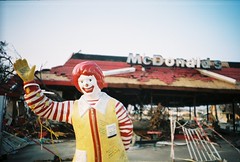Quick disclaimer: I realize there is still a lot of rescuing, grieving, and hard work to do in the Gulf coast. I respect the city of New Orleans, and its people. This post is just me thinking out loud about a bigger issue, possibly prompted mainly by my “corruption” in English Lit grad school.
I just read this article in the Washington Post — A Sad Truth: Cities Aren’t Forever — and wondered about a few things.
Only in July, I heard a wonderful story on NPR about the 100 year old restaurant Galatoire’s, where various folks were interviewed about its history and its long-time clientele. The verbal posture and language, the way these people spoke of the area and its sultry, complex eccentricities, reminded me of something, but I wasn’t sure what.
Finally I realized what it reminded me of: the way expatriates talk about the near-third-world places where they’ve set up shop with their little typewriters over the last hundred years or so. Hemingway in Mexico or Spain, or William Burroughs in Tangier (and Mexico too, for that matter). Other examples that I can’t think of at the moment … but it made me wonder other stuff …
Was the “New Orleans” so many of us romanticize actually a sort of last-bastion of this kind of existence? That is, relatively well-off intellectual white folks sipping coffee (or bourbon or whatever) in old-world surroundings, steeped in “dark” mystery? It makes me think of Post-Colonial Lit Theory: essentially the worldview and literature sprouting from a people who occupy another, weaker or poorer (or at least colonized) country or people.
I’m oversimplifying, and maybe even misappropriating, but New Orleans has always seemed the sort of place where people could be writers and artists and languidly soak up the atmosphere of the place, and then use it as grist for their typewritten mills, without actually having to be one of the poor and downtrodden folk who make up the majority of the mysterious “dark” (yeah that word is, in an academic sense, “problematized,” because of the racial connection, but here I’ll only acknowledge it; to get into it much would be a huge tangent) vibe surrounding them.
Even one of my favorite James Bond movies, “To Live and Let Die,” takes place partly in New Orleans and in the Caribbean, and makes great use of the “voodoo” spookiness and, let’s face it, sultry sexuality through a Hollywood lens. Same for the infamous “Angel Heart” film, with chicken blood and everything.
What I’m getting at is this: when I read the article I linked above, I wondered if the romantic New Orleans that so many of us want to fight to preserve is really just a sort of weird Disney World version of the city that’s built on the backs of the hundreds of thousands of poor people surrounding it? Evidently what most outsiders (and the relatively well-off in NO) like to think of as New Orleans is really just a small part of the city, a crescent slice of Orleans Parish.
From the article:
That tourist crescent is relatively intact. (Only two of the 1,500 animals at the Audubon Zoo died.) But it is only perhaps 10 percent of the city. … The rest to the north of the river … is under as much as 25 feet of water. For the last 90 years, this vast bulk of the city has required mammoth pumps to clear the streets every time it rains. This is where you’d find … areas of soul-destroying poverty, part of the shredding fabric of a city that had a poverty rate of 23 percent. …
Plus there’s the rest of the city, which doesn’t fare much better (many of the other parishes). Does this explain in part the huge failure of preparation and evacuation? (although to be fair, hundreds of thousands of even the very poor *were* rescued and evacuated) I mean, though, is part of the reason that many of the levees never were quite up to par was that those parts of the city were systemically written off in the collective imagination of the culture?
If I were still in academia, I’d jump on this concept: of New Orleans as a last holdout of post-colonial romanticism.
This isn’t to say that all the people in the city don’t deserve to have their homes back. It’s not to condone the situation in any way. It just makes me wonder if we need to question some assumptions.





